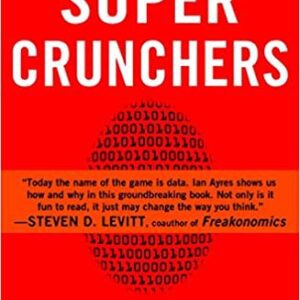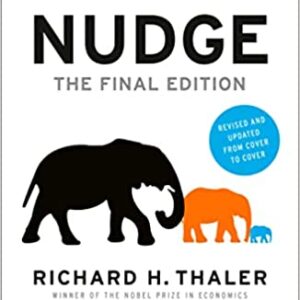Description
Blink: The Power of Thinking Without Thinking
In this book, Malcolm Gladwell explores the power of rapid cognition, which he calls “thin-slicing.” Thin-slicing refers to the ability to make quick decisions or judgments based on a small amount of information. Gladwell argues that our brains are wired to process vast amounts of information in an instant, and that this ability is both a blessing and a curse.
Gladwell begins by examining the example of the Getty kouros, a ancient marble statue that was purchased by the J. Paul Getty Museum in California. The statue was later discovered to be a forgery, despite extensive analysis by scientists and art historians. Gladwell argues that this case highlights the limitations of conscious thinking and the importance of unconscious processing.
The book then turns to the field of psychology, where Gladwell discusses the work of John Gottman, a researcher who has spent years studying marriage and relationships. Gottman’s research has shown that couples can be predicted with high accuracy based on their behavior in just a few minutes. However, this success is due in part to the fact that many people are not aware of how they feel about their partner, despite being able to describe their feelings in detail.
Gladwell also discusses the concept of “thin-slicing,” which refers to the ability to make quick judgments based on limited information. He argues that thin-slicing is a powerful tool for decision-making and problem-solving, but it can also lead to biases and errors.
One of the most famous examples of thin-slicing is the case of Paul Van Riper, a Marine Corps general who played the role of a rogue military commander in a war game called Millennium Challenge ’02. Van Riper’s team was able to outmaneuver their opponents using unconventional tactics, which caught Blue Team off guard.
Gladwell also discusses the importance of context and environment when it comes to decision-making. He argues that our surroundings and experiences shape our perceptions and influence our judgments.
The book also touches on the topic of implicit associations, which are automatic connections between ideas or concepts. Gladwell argues that these associations can be both creative and destructive, depending on the context in which they arise.
One of the most interesting examples of implicit association is the case of Warren Harding, who was elected President of the United States in 1920 due to his good looks and charm. Despite being unqualified for the job, Harding won over voters with his physical appearance and charisma.
Gladwell also discusses the concept of ” priming,” which refers to the influence of external stimuli on our thoughts and behaviors. He argues that we are often unaware of how these external stimuli shape our decisions, but they can have a profound impact.
The book concludes by highlighting the importance of being aware of our own biases and assumptions when it comes to decision-making. Gladwell argues that thin-slicing is not always a guarantee of success, and that we must be mindful of our own limitations and vulnerabilities.
Throughout the book, Gladwell draws on a wide range of examples and case studies to illustrate his points. From the power of music and food experts to the challenges of hiring musicians for orchestras, he shows how thin-slicing can be both a strength and a weakness.
Overall, Blink is a thought-provoking and engaging book that explores the complexities of human cognition and decision-making. It offers a new perspective on the way we think and make decisions, and highlights the importance of being aware of our own biases and assumptions in order to achieve success.
Key Takeaways:
* Thin-slicing refers to the ability to make quick judgments based on limited information.
* Our brains are wired to process vast amounts of information in an instant, but this ability can also lead to biases and errors.
* Context and environment play a significant role in shaping our perceptions and influencing our judgments.
* Implicit associations can be both creative and destructive, depending on the context in which they arise.
* Priming is the influence of external stimuli on our thoughts and behaviors, and we are often unaware of how these external stimuli shape our decisions.
* Thin-slicing is not always a guarantee of success, and we must be mindful of our own limitations and vulnerabilities.
Main Arguments:
* Thin-slicing is a powerful tool for decision-making and problem-solving, but it can also lead to biases and errors.
* Context and environment play a significant role in shaping our perceptions and influencing our judgments.
* Implicit associations can be both creative and destructive, depending on the context in which they arise.
* Priming is the influence of external stimuli on our thoughts and behaviors, and we are often unaware of how these external stimuli shape our decisions.
* Thin-slicing is not always a guarantee of success, and we must be mindful of our own limitations and vulnerabilities.
Important Examples:
* The Getty kouros example highlights the limitations of conscious thinking and the importance of unconscious processing.
* John Gottman’s research on marriage and relationships shows that couples can be predicted with high accuracy based on their behavior in just a few minutes.
* Paul Van Riper’s case study demonstrates the power of unconventional tactics in decision-making.
* Warren Harding’s election as President highlights the influence of implicit associations on our decisions.
* The priming experiments discussed by John Bargh and Keith Payne show how external stimuli can shape our thoughts and behaviors.
Significant Points:
* Our brains are wired to process vast amounts of information in an instant, but this ability can also lead to biases and errors.
* Context and environment play a significant role in shaping our perceptions and influencing our judgments.
* Implicit associations can be both creative and destructive, depending on the context in which they arise.
* Priming is the influence of external stimuli on our thoughts and behaviors, and we are often unaware of how these external stimuli shape our decisions.
* Thin-slicing is not always a guarantee of success, and we must be mindful of our own limitations and vulnerabilities.
In his landmark bestseller
- ASIN : 0316010669
- Publisher : Back Bay Books; Annotated edition (April 3, 2007)
- Language : English
- Paperback : 296 pages
- ISBN-10 : 9780316010665
- ISBN-13 : 978-0316010665
- Lexile measure : 1100L
- Item Weight : 10.6 ounces
- Dimensions : 5.5 x 0.88 x 8.25 inches





Reviews
There are no reviews yet.